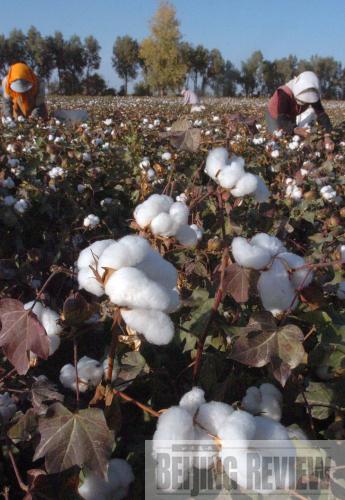|
The rosy figure is a result of the region's pursuit of alternative sources of growth. Since 2005, the region has been diversifying into a number of sectors, including modern manufacturing, the coal chemical industry and textiles.
The downturn has provided an opportunity for the region to rebalance its industrial structures and reposition itself for future challenges, Yang Yibo, Deputy Director of the commission, told Beijing Review.
A push into innovative high technologies and energy conservation has also supported the industrial diversification drive, he added.
Manufacturing headway
As the Xinjiang economy begins to recover, the region is also experiencing an upsurge in modern manufacturing. The new industry, reaping the benefits of modern technologies and management prowess, has exhibited an impressive degree of advances in high value-added production. In addition, a number of world-leading manufacturers are moving further into the remote inland region in order to obviate the higher costs of labor and land use in coastal regions.
More importantly, Urumqi is building an international manufacturing base, Mayor Gela Yishamudin said in an interview with Beijing Review. The first step was marked by the establishment of the Economic and Technology Development Zone, which has attracted hundreds of modern manufacturers with tax and financing incentives, he said. Despite declining demand for industrial products, the city's geographic advantages and proximity to rich resources give its manufacturing sector an edge, he said.
A pillar enterprise in the zone is the Shenzhen-listed Goldwind Science and Technology Co. Ltd., a top maker of wind-power generators whose market share last year ranked second domestically and eighth globally. In a sector that entails precision production and specialist knowledge of aerodynamics and computer science, the company is obviously getting into full swing.
Its latest product, a 1.5-megawatt turbine, has been a market hit since last year when it was developed on the back of independent research and technological innovations. The company's quarterly report showed its first-quarter profit jumped 150 percent year on year. The country's commitment to clean and renewable energy is also good news for Goldwind and other alternative energy companies.
"Despite the bleak business mood, we have been flooded with orders for the new machines," said Jesur Ablikem, Assistant to President of Goldwind. "Compared with major competitors, our biggest advantage lies with the new technologies that increase efficiency and provide safety insurance."
Green chemicals
There is no doubt that one significant spur for the region's economic takeoff has been the breakthrough discovery of its vast mineral wealth. But simply digging coal and oil out of the ground does not necessarily create much added value or the jobs that are most needed for the nascent economy. As a solution, Xinjiang moved downstream along the industrial chain into a series of chemical industries such as methanol, olefin and urea. But the business faces the dangerous and intractable problem of industrial waste that is slow to biodegrade. Traditional incineration and land-filling methods usually give rise to environmental contamination and cost inflation.
 |
|
SILK SPRING: Xinjiang is moving from cotton production to textile manufacturing (XINHUA) |
The experience of Tianye Group, a Xinjiang-based PVC (Polyvinylchloride) maker, helps illustrate how a green initiative could recycle resources and create cost advantages as well. PVC is commonly used in construction, clothing and plastics industries, but its manufacturing results in large quantities of carbide residue that is particularly hazardous to the environment.
After years of research, the company developed advanced technologies that could produce quality cement out of the carbide residue. Meanwhile, an elaborate pressure swing absorption process removes impurities from the waste gas, making it reusable for PVC production. Wastewater is also purified for re-circulation.
Unlike its crisis-stricken competitors, who have idled their machines as they wait for the economic situation to turn around, the relatively resilient Tianye Group is building up new capacities, aiming to multiply its annual PVC output to 1.5 million tons in two years.
| 